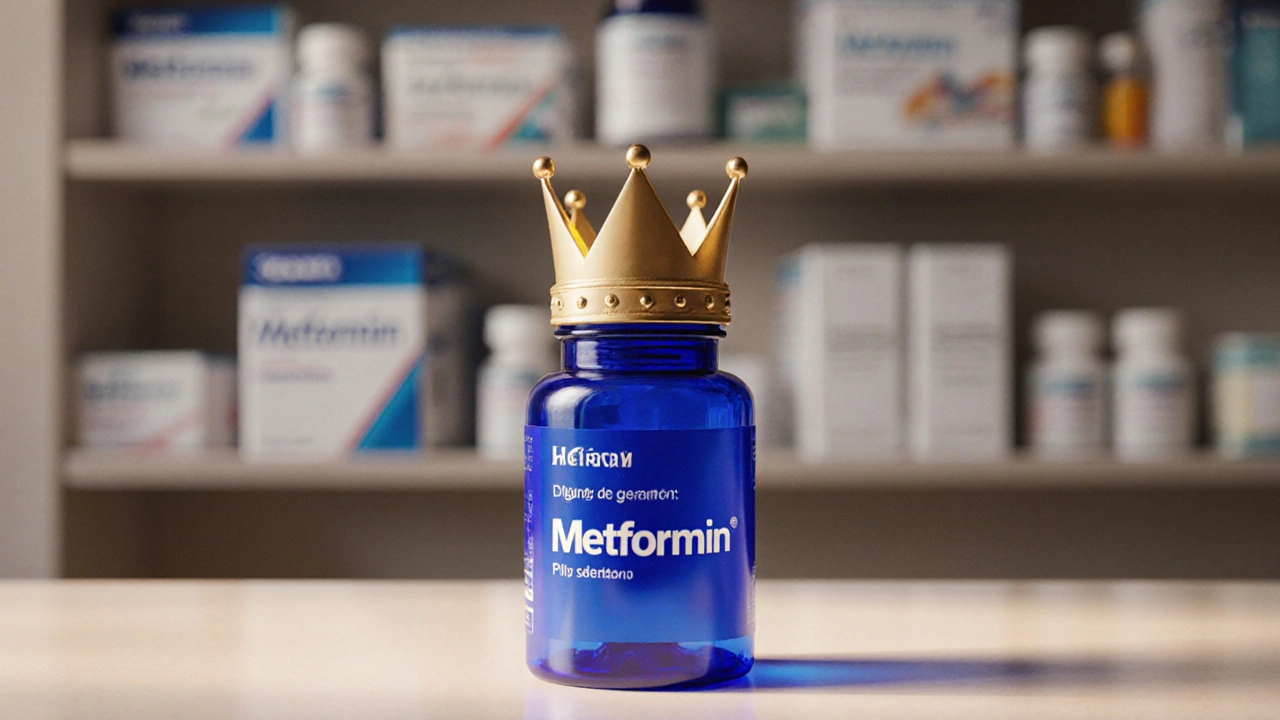Diabetes Medication Comparison Tool
This tool helps you compare the top diabetes medications based on key factors mentioned in the article. Select your priorities to see which medications best match your needs.
Your Priorities
Select what matters most to you when considering diabetes medication:
Medication Comparison
Metformin
First-line Low cost Low side effects Weight neutral/loss
The most prescribed diabetes medication with proven track record, low cost, and minimal side effects.
When you hear people talk about a diabetes medication that’s everywhere, chances are they’re referring to a single pill that has become a household name. It isn’t hype; it’s data. In the United States and many other countries, one drug consistently tops the prescription charts for managing diabetes. Let’s explore why that is, how it works, and what the other popular options look like.
What does “most popular” really mean?
Popularity in the medical world is measured by prescription volume, not by marketing hype. The American Diabetes Association (ADA) publishes annual reports that tally how many times each drug is prescribed. In 2024, more than 30 % of all diabetes prescriptions were for a single molecule - Metformin is a biguanide oral medication that lowers blood sugar by reducing liver glucose production and improving insulin sensitivity. That share dwarfs the next‑most prescribed classes, which sit in the low‑teens.
Who needs a diabetes medication?
Diabetes isn’t a one‑size‑fits‑all condition. Roughly 90‑95 % of cases are Type 2 diabetes, a progressive disorder where the body either resists insulin or doesn’t produce enough. The other 5‑10 % are Type 1 diabetes, an autoimmune condition that destroys insulin‑producing beta cells. While both types eventually need blood‑glucose control, the medication toolbox differs.
Why Metformin reigns supreme
- Proven track record: First approved by the FDA in 1994, Metformin has been studied in thousands of clinical trials. Long‑term data show it reduces cardiovascular events and may even lower certain cancer risks.
- Safety profile: Compared with sulfonylureas or insulin, Metformin carries a low risk of causing dangerously low blood sugar (hypoglycemia). The most common side effects are mild gastrointestinal upset, which many patients manage by starting with a low dose.
- Cost‑effectiveness: As a generic drug, a month’s supply often costs under $10, making it accessible for patients without insurance.
- Weight neutral or modest loss: Unlike some older agents that promote weight gain, Metformin may help shed a few pounds, an added bonus for many with Type 2 diabetes.
How Metformin works under the hood
Metformin’s primary actions are twofold. First, it inhibits hepatic gluconeogenesis, meaning the liver releases less glucose into the bloodstream. Second, it improves peripheral insulin sensitivity, helping muscle and fat cells take up glucose more efficiently. The drug also has a modest impact on the gut microbiome, which researchers believe contributes to its glucose‑lowering effect.

Other major players in the diabetes arena
While Metformin dominates the first‑line treatment, several newer classes have gained traction, especially for patients who need tighter control or have specific health concerns. Below is a quick snapshot of the top five medication groups by prescription share in 2024.
| Medication | Drug Class | Typical Use | Approx. Prescription Share % |
|---|---|---|---|
| Metformin | Biguanide | First‑line for Type 2 | 30 |
| Glucagon‑like peptide‑1 (GLP‑1) agonists | GLP‑1 RA | Weight loss & cardiovascular benefit | 12 |
| SGLT2 inhibitors | SGLT2‑i | Kidney protection, heart failure | 10 |
| Sulfonylureas | Sulfonylurea | Cheap second‑line option | 9 |
| Insulin | Hormone replacement | Type 1 or advanced Type 2 | 8 |
When might a doctor choose something other than Metformin?
Even though Metformin is the go‑to drug, it isn’t suitable for everyone. Patients with severe chronic kidney disease (eGFR <30 mL/min/1.73 m²) may need dose adjustments or an alternative. Those experiencing persistent nausea despite low‑dose titration might switch to a GLP‑1 agonist, which, while pricier, often resolves gastrointestinal issues and adds weight‑loss benefits.
Key factors influencing medication choice
- Glycemic target: If a patient’s HbA1c is just a few points above goal, Metformin alone may suffice. For higher targets, combination therapy is common.
- Cardiovascular risk: GLP‑1 agonists and SGLT2 inhibitors have proven heart‑protective effects, making them attractive for patients with existing heart disease.
- Kidney function: Metformin’s dose must be reduced as kidney function declines, while SGLT2 inhibitors require a minimum eGFR of ~45 mL/min/1.73 m² for efficacy.
- Weight considerations: Sulfonylureas can cause weight gain; GLP‑1 agonists often produce weight loss.
- Cost and insurance coverage: Generic Metformin is the most affordable; newer agents may need prior authorization.

Common misconceptions about Metformin
- “It’s only for old people.” - Metformin is prescribed to adults of all ages, including young adults diagnosed early.
- “It causes dangerous low blood sugar.” - Unlike insulin or sulfonylureas, Metformin alone rarely triggers hypoglycemia.
- “You have to take it forever.” - While many stay on Metformin long‑term, some achieve remission through lifestyle changes and can reduce or stop the drug under medical supervision.
Practical tips for taking Metformin effectively
- Start with 500 mg once a day with dinner; increase weekly to 500 mg twice daily as tolerated.
- Take the tablet with food to lessen stomach upset.
- Stay hydrated; dehydration can raise the risk of the rare but serious lactic acidosis.
- Inform your doctor before any major surgery, as the drug is often paused temporarily.
Future outlook: What could shift the popularity rankings?
Emerging therapies like dual‑agonist molecules (combining GLP‑1 and GIP activity) are showing impressive HbA1c reductions and weight loss. If prices drop and long‑term safety data solidify, we might see a gradual shift away from Metformin as the dominant first‑line agent. However, the inertia of decades‑long clinical experience and low cost make a rapid dethronement unlikely.
Frequently Asked Questions
Is Metformin safe for people with mild kidney impairment?
Yes, but the dose should be reduced. Current guidelines recommend a maximum dose of 1000 mg daily if eGFR is between 30‑45 mL/min/1.73 m². Below 30, Metformin is usually avoided.
Can Metformin cause weight loss?
Many patients report modest weight loss (1‑3 kg) in the first few months, largely because the drug improves insulin sensitivity and may reduce appetite.
What should I do if I experience nausea on Metformin?
Try a slow‑release (XR) formulation, take it with a larger meal, or split the dose into smaller increments throughout the day. If symptoms persist, consult your doctor for an alternative.
How does Metformin compare to insulin in lowering HbA1c?
Metformin typically reduces HbA1c by 1‑1.5 percentage points, while basal insulin can lower it by 1‑2 points. The key difference is the risk of hypoglycemia-insulin carries a higher risk.
Is it okay to stop Metformin once my blood sugar is under control?
Only under medical supervision. Sudden discontinuation can cause rebound hyperglycemia. A doctor may taper the dose while monitoring lifestyle changes.

 Best Countries for Surgery in 2025: Costs, Safety, and How to Choose
Best Countries for Surgery in 2025: Costs, Safety, and How to Choose
 Coping with Your Husband After Heart Surgery
Coping with Your Husband After Heart Surgery
 Top Hospitals for Orthopedic Surgeries You Should Know About
Top Hospitals for Orthopedic Surgeries You Should Know About
 Understanding Trazodone: Is It a Narcotic?
Understanding Trazodone: Is It a Narcotic?
 What Doctor Prescribes Weight Loss Pills? Your Guide to the Right Specialist
What Doctor Prescribes Weight Loss Pills? Your Guide to the Right Specialist